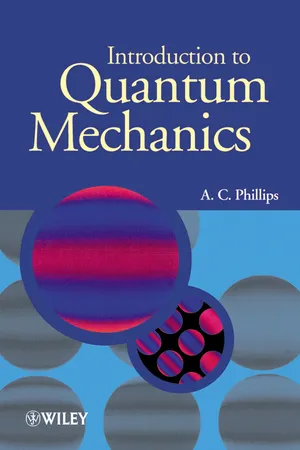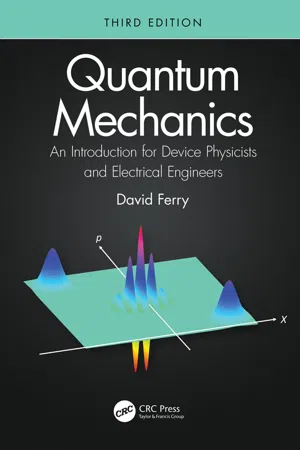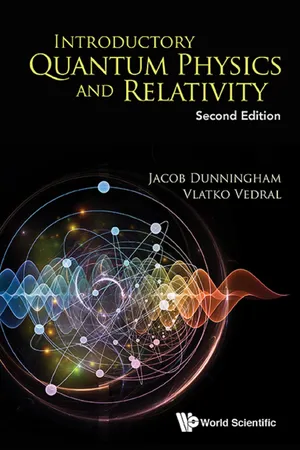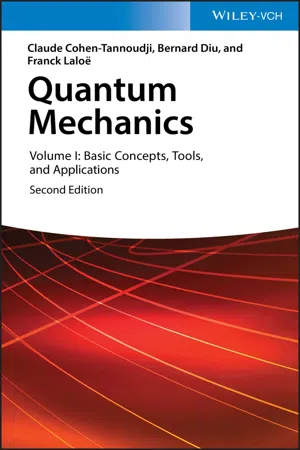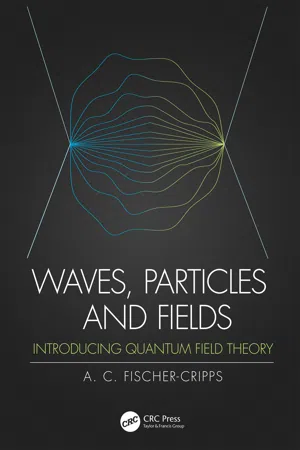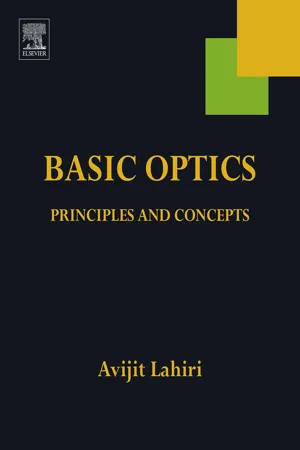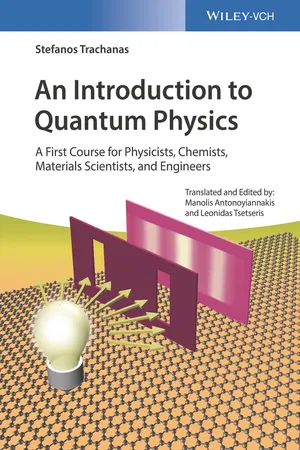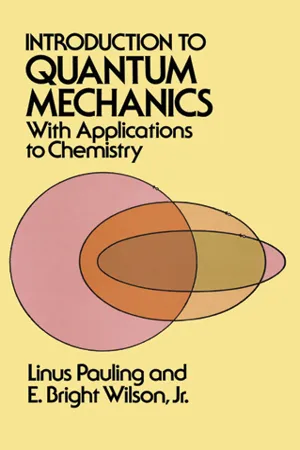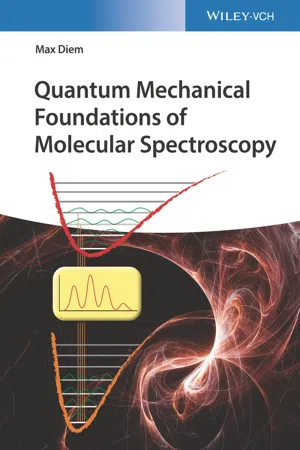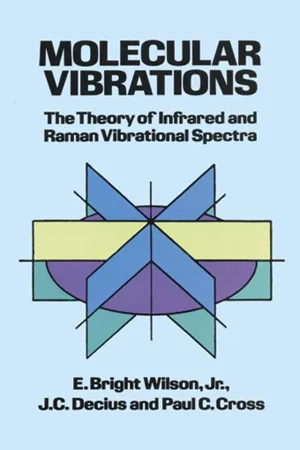Physics
Quantum Harmonic Oscillator
The quantum harmonic oscillator is a model used in quantum mechanics to describe the behavior of a particle that is subject to a restoring force proportional to its displacement from equilibrium. It is a fundamental concept in quantum mechanics and has applications in various fields such as chemistry and materials science.
Written by Perlego with AI-assistance
Related key terms
Related key terms
1 of 4
Related key terms
1 of 3
12 Key excerpts on "Quantum Harmonic Oscillator"
- eBook - ePub
- A. C. Phillips(Author)
- 2013(Publication Date)
- Wiley(Publisher)
In the real world of quantum mechanics, simple harmonic motion with definite energy, frequency, phase and amplitude never really happens. We shall see that oscillators either have definite energy and do not oscillate, or they oscillate with uncertain energy. However, we shall see that, in special circumstances, the oscillations are almost like simple harmonic motion.6.2 THE QUANTUM OSCILLATOR
The definingproperty of a quantum system is its Hamiltonian operator. For a one-dimensional harmonic oscillator the Hamiltonian operator isor, if we use Eq. (3.30) ,(6.7)The first term represents the kinetic energy operator for a particle of mass m and the second term represents the potential energy operator for a particle in a potential well which, in classical physics, would give rise to simple harmonic motion with angular frequency ω .The behaviour of a particle in a harmonic oscillator potential is more varied in quantum physics than in classical physics. There are an infinite number of quantum states; some are stationary states with definite energy and some are non-stationary states with uncertain energy. Each of these states is described by a wave function Ψ(x , t ) which satisfies the Schrödinger equation,(6.8)with the Hamiltonian given by Eq. (6.7) .The quantum states with definite energy will be our first concern. As we saw in Section 4.3, states with energy E are represented by a wave function of the form(6.9)where ψ (x ) is an eigenfunction belonging to an energy eigenvalue E . If we substitute for Ψ(x , t ) into Eq. (6.8) and use Eq. (6.7) , we obtain the energy eigenvalue equation:(6.10)When we seek solutions to this equation, we shall impose the physical requirement that the wave function of the particle is normalizable. To do this, we shall require the eigenfunctions to go to zero at infinity; i.e.(6.11)Because the sides of the harmonic oscillator potential, like the walls of the infinite square-well potential, are infinitely high, we expect an infinite number of quantized eigenvalues. We shall denote these byEn, and the corresponding eigenfunctions byψn(x ), where n is a quantum number. We shall follow the convention of labelling the ground state by n = 0 and the first, second and thirdmexcited states, etc, by n = 1,2,3,….1 - eBook - ePub
Quantum Mechanics
An Introduction for Device Physicists and Electrical Engineers
- David Ferry(Author)
- 2020(Publication Date)
- CRC Press(Publisher)
5The Harmonic Oscillator
One of the most commonly used quantum mechanical systems is that of the simple harmonic oscillator . The prototype system is the simple pendulum. Classically, the motion of the system exhibits harmonic, or sinusoidal oscillations. Quantum mechanically, the motion described by the Schrödinger equation is more complex. Although quite a simple system in principle, the harmonic oscillator assumes almost overwhelming importance due to the fact that it is one of the few systems that can be solved exactly in quantum mechanics. Almost any interaction potential may be expanded in a Tayor series with the low-order terms (up to quadratic order) cast into a form described by the harmonic oscillator. The sinusoidal motion of classical mechanics is the simplest system that produces oscillatory behavior, and therefore is found in almost an infinity of physical systems. Thus, the properties of the harmonic oscillator become important for their use in describing quite diverse physical systems. In this chapter, we will develop the general mathematical solution for the wave functions of the harmonic oscillator, using a simple operator algebra that allows us to obtain these wave functions and properties in a much more usable and simple manner. Classically, the harmonic oscillator is described in terms of Hermite polynomials, as the differential equation is one of the variants of the Sturm-Liouville problem. We can obtain these functions without the normal complication of solving the detailed differential equation, as the operator approach makes life easier. We then turn to two classic examples of systems in which we use the results for the harmonic oscillator to explain the properties: the simple LC - eBook - ePub
- Jacob Dunningham, Vlatko Vedral(Authors)
- 2018(Publication Date)
- WSPC(Publisher)
Of course, the same is also true for the probability that the particle is on the right side of the box. And this is the same as the classical particle. So, if we average over quantum probabilities, we obtain the classical ones.4.2.The Quantum Harmonic Oscillator
Another important type of potential that is worth studying is the Quantum Harmonic Oscillator. Just as the harmonic oscillator is important in classical physics as a prototype for more complex oscillations, the Quantum Harmonic Oscillator plays a key role in quantum physics. We will see this later in the book, particularly when we come to discuss quantum field theory in Chapter 11 .The classical harmonic potential describes systems obeying Hooke’s law, such as a mass on a spring or a marble rolling around in a parabolic container. The harmonic potential is given bywhere ω is a constant describing the frequency of the potential, i.e. the rate at which a classical particle would complete a full oscillation. We know that to describe the motion of a quantum particle, we need to solve the Schrödinger equation. Substituting this potential into the one-dimensional Schrödinger equation, we getThe first three solutions to this are3where has the dimensions of length and corresponds to the classical turning point of an oscillator in the n = 0 ground state.4As expected, stationary states of a Quantum Harmonic Oscillator exist only for certain discrete energy levels. The allowed energies are given byFigure 4.2 shows the first three energy levels and wave functions of a Quantum Harmonic Oscillator. The energy levels have the special property of being equally spaced at ΔE = ħω. This result is different from that of a particle in a box, where the energy levels get increasingly further apart. We can also see in Fig. 4.2 - eBook - ePub
Quantum Mechanics, Volume 1
Basic Concepts, Tools, and Applications
- Claude Cohen-Tannoudji, Bernard Diu, Franck Laloë(Authors)
- 2020(Publication Date)
- Wiley-VCH(Publisher)
1 .The harmonic oscillator is also involved in the study of the electromagnetic field. We know that in a cavity, there exist an infinite number of possible stationary waves (normal modes of the cavity). The electromagnetic field can be expanded in terms of these modes and it can be shown, using Maxwell’s equations, that each of the coefficients of this expansion (which describe the state of the field at each instant) obeys a differential equation, which is identical to that of a harmonic oscillator whose angular frequency is that of the associated normal mode. In other words, the electromagnetic field is formally equivalent to a set of independent harmonic oscillators (cf. Complement KV ). The quantization of the field is obtained by quantizing these oscillators associated with the various normal modes of the cavity (cf. Chapter XIX). Recall, moreover, that it was the study of the behavior of these oscillators at thermal equilibrium (blackbody radiation) which, historically, led Planck to introduce, for the first time in physics, the constant h which bears his name. We shall see (cf. Complement LV ) that the mean energy of a harmonic oscillator in thermodynamic equilibrium at the temperature T is different for classical and quantum mechanical oscillators.The harmonic oscillator also plays an important role in the description of a set of identical particles which are all in the same quantum mechanical state (they must obviously be bosons, cf. Chap. XIV). As we shall see later, this is because the energy levels of a harmonic oscillator are equidistant, the spacing between two adjacent levels being equal to . With the energy level labelled by the integer n (situated at a distance above the ground state) can then be associated a set of n identical particles (or quanta), each possessing an energy (cf. Chapter XV). The transition of the oscillator from level n to level n + 1 or n – 1 corresponds to the creation or annihilation of a quantum of energy . In this chapter, we shall introduce the operators and a, which enable us to describe this transition from level n to level n + 1 or n – 1. These operators, respectively called “creation” and “annihilation” operators2 , are used throughout quantum statistical mechanics and quantum field theory3 - eBook - ePub
Waves, Particles and Fields
Introducing Quantum Field Theory
- Anthony C. Fischer-Cripps(Author)
- 2019(Publication Date)
- CRC Press(Publisher)
There are various approaches used for quantising fields. In one method, the raising and lowering field operators are used in conjunction with the Hamiltonian to find the spectrum of energies. This procedure is called canonical quantisation. It is a difficult procedure and even more so when extended to the Dirac (spin ½) and electromagnetic (spin 1) fields, not to mention including relativity and normalisation.In another method, quantisation is arrived at through the action principle and the Lagrangian. We will not examine this method here since, for our simple harmonic oscillator field, it is not necessary for our understanding. For more complicated fields, it provides a much easier pathway to quantisation than the canonical method.16.3.5 The Quantum Field
The Quantum Harmonic Oscillator field described in the previous section has been a free field in the sense that each oscillator is independent of the others.In a solid, molecules are connected to one another by molecular bonds. Sound waves travel through the solid as displacements of molecules around their equilibrium positions, and, since all the molecules are connected with each other, elastic waves can travel through the solid. In our harmonic oscillator field, we might imagine that, as well as the masses being supported by springs, that also, the masses are connected sideways with each other by springs that cause the up and down movement of one oscillator to be transmitted to the one next to it. This is shown in Figure 16.2 (a).FIGURE 16.2 (a) Interconnected masses and springs for a simple harmonic oscillator model. (b) Horizontal springs only showing connection between masses to simulate a stretched string.In fact, we don’t even need to worry about the spring that supports the mass from below but instead, only those that act from the side as shown in Figure 16.2 - eBook - ePub
Basic Optics
Principles and Concepts
- Avijit Lahiri(Author)
- 2016(Publication Date)
- Elsevier(Publisher)
correlations between the field intensities at the points under consideration.Before undertaking a more detailed description of certain types of states of the electromagnetic field and observable effects relating to these states, I include below a brief survey of the quantum mechanical harmonic oscillator since in numerous situations of practical interest the electromagnetic field can be described in terms of a collection of harmonic oscillators. Special states of the harmonic oscillator such as the number states, coherent states, and the squeezed states are of considerable relevance in the quantum description of states of the electromagnetic field.8.4 The Harmonic Oscillator
8.4.1 The Number States: Creation and Annihilation Operators
The classical harmonic oscillator is described by the Hamiltonian function (8.1 ), while in the quantum description one refers to the Hamiltonian operator (8.51 ). Classically, if one starts from a point (q , p ) in the phase space at an initial instant of time, then subsequently q and p vary sinusoidally with angular frequency ω , and the representative point in the phase space describes an elliptic trajectory. The representative point at any given time instant represents a pure classical state of the oscillator, while a collection of points making up a region of the phase space, with some particular probability density defined over the region, defines a mixed classical state. While both q and p have precisely defined values for a pure state, their values can be given only in statistical terms for a mixed state.The quantum theory of the harmonic oscillator is crucially relevant to quantum optics, where it provides the basis for describing quantum states of the electromagnetic field. A set of pure states of central importance for the harmonic oscillator are the eigenstates of the Hamiltonian, also termed stationary states . These eigenstates form a discrete set that can be enumerated with an index, say, n (= 0, 1, 2, …), a typical normalized eigenstate |n - eBook - ePub
An Introduction to Quantum Physics
A First Course for Physicists, Chemists, Materials Scientists, and Engineers
- Stefanos Trachanas, Manolis Antonoyiannakis, Leonidas Tsetseris(Authors)
- 2017(Publication Date)
- Wiley-VCH(Publisher)
Chapter 6 The Harmonic Oscillator 6.1 Introduction The harmonic oscillator is, surely, the most “classic” problem of classical mechanics. Its theory is simple. If a particle with mass is subject to a restoring force 6.1 which is proportional to the displacement from an attractive center at, then Newton's equation is written as The solution of this equation takes the sinusoidal form 6.2 which represents a harmonic oscillation of the particle with frequency and period Note that the period is independent of the amplitude denoted by the constant in the solution (6.2). This unique feature of the classical harmonic oscillator has its quantum analog, as we shall see soon. The force (6.1) comes from a potential defined by the familiar relation where is known as the parabolic potential, or the potential of a harmonic oscillator. Its characteristic shape is shown in Figure 6.1. Figure 6.1 The potential of a harmonic oscillator. The significance of the parabolic potential stems from the fact that it is a very good approximation to any potential in the vicinity of a stable equilibrium point. Indeed, consider an arbitrary one-dimensional potential with a local minimum (i.e., a stable equilibrium point), which we place at the origin of the -axis. We can then expand in a Taylor series around to find 6.3 Since is a stable equilibrium point, we have and. Furthermore, since we can choose the potential energy reference level at will, we can set, and thus write (6.3) as The higher powers in this expansion can be neglected for small (i.e., for small oscillations around the equilibrium point), in which case only the “parabolic term” survives; it provides a good approximation of the full potential in the vicinity of its minimum (see Figure 6.2). As we see later in the book, the parabolic approximation —a plausible name for the given process—finds a straightforward application in the study of the vibrational motion of diatomic molecules. Figure 6.2 The parabolic approximation - Linus Pauling, E. Bright Wilson, E. Bright Wilson(Authors)
- 2012(Publication Date)
- Dover Publications(Publisher)
Sec. 40c ).FIG . 11–1.—Energy levels for the harmonic oscillator according to wave mechanics (see Fig. 6–1 ).11b. The Wave Functions for the Harmonic Oscillator and Their Physical Interpretation. —For each of the characteristic valuesWnof the energy, a satisfactory solution of the wave equation 11–1 can be constructed by the use of the recursion formula 11–7. Energy levels such as these, to each of which there corresponds only one independent wave function, are said to be non-degenerate to distinguish them from degenerate energy levels (examples of which we shall consider later), to which several independent wave functions correspond. The solutions of 11–1 may be written in the formin which .Hn(ξ) is a polynomial of the n th degree in ξ, andNnis a constant which is adjusted so that is normalized, i.e., so that satisfies the relationin which , the complex conjugate of , is in this case equal to . In the next section we shall discuss the nature and properties of these solutions in great detail. The first of them, which corresponds to the state of lowest energy for the system, isFIG . 11–2.—The wave function for the normal state of the harmonic oscillator (left), and the corresponding probability distribution function (right). The classical distribution function for an oscillator with the same total energy is shown by the dashed curve.Figure 11–2 shows this function. From the postulate discussed in Section 10a , , which is also plotted in Figure 11–2- Max Diem(Author)
- 2021(Publication Date)
- Wiley-VCH(Publisher)
4 The Harmonic Oscillator, a Model System for the Vibrations of Diatomic MoleculesThe atoms in molecules are in constant vibrational motion that is a manifestation of the heat content or temperature of matter. These vibrational motions appear to be random but can be decomposed into movement along certain coordinates, which will be discussed in Chapter 5 . The amplitude of these motions increases with increasing temperature. Completely stopping this motion is impossible, as we shall see in this and the following chapter, and also would violate the third law of thermodynamics as it could create a complete order and absolute‐zero temperature.This chapter will introduce the next logical model system commonly discussed in quantum mechanics, the vibrational motion of a diatomic molecule obeying the harmonic oscillator approximation. This model, for which the Schrödinger equation still can be solved exactly, already is much closer to real molecular systems than the particle‐in‐a‐box model introduced in Chapter 2 and describes the molecular vibration of diatomic molecules adequately. Further modification to this model (by introducing the anharmonicity) refines it to the point where real diatomic molecules can be described with very high accuracy.4.1 Classical Description of a Vibrating Diatomic Model System
The harmonic oscillator model is usually introduced for a diatomic molecule, as shown in Figure 4.1 . Here, two atoms with masses m1 and m2 are connected by a covalent chemical bond along the x‐direction. This bond can be thought of as a spring with a restoring force F obeying Hook's law:(4.1)where k is the force constant of the spring, expressed in units of [N/m]. The potential energy V created when extending or compressing this spring by the distant dx- eBook - ePub
Entropy and Free Energy in Structural Biology
From Thermodynamics to Statistical Mechanics to Computer Simulation
- Hagai Meirovitch(Author)
- 2020(Publication Date)
- CRC Press(Publisher)
Also, because the quantum oscillator can be solved analytically, it would be of interest to demonstrate that the correspondence principle is satisfied, that is, the quantum description leads to the classical one at high T. One should first solve the Schrödinger equation for a harmonic oscillator in dimension d = 1, Ĥ ψ = E ψ; ψ is the wave function, E stands for energy values, and Ĥ is the Hamiltonian operator, H ^ = − ℏ 2 2 m d 2 d x 2 + V (x) (4.44) The first term in Equation (4.44) is the kinetic energy operator with the Planck constant, ℏ = h /2π and the mass, m ; V (x) is the potential energy operator, V (x) = fx 2 /2, and the Schrödinger equation. is, H ^ = − ℏ 2 2 m d 2 ψ 2 d x 2 + 1 2 f x 2 ψ = E ψ (4.45) The solution of this equation leads to a set of energy levels [ 1 ], E n = (n + 1 2) h ν n = 0, 1, …, ∞ (4.46) where the frequency, ν, is defined by Equation (4.34). The partition function, q, of a single quantum oscillator is obtained by summing up the exponentials of the energy levels, q = ∑ n exp [ − E n k B T ] (4.47) and the Boltzmann probability is: P n B = exp [ − E n / k B T ] q (4.48) Specifically, using the summation formula of a geometric series one. obtains, q = ∑ n = 0 ∞ exp − (n + 1 / 2) h ν k B T = exp [ − (1 / 2) h ν k B T ] 1 1 − exp − h ν k B T (4.49) and the free energy of a single oscillator, A sin,. is: A sin = − k B T ln q = (1 / 2) h ν + k B T ln [ 1 − exp (− h ν k B T) ]. (4.50) The energy E sin of a single oscillator. is, E sin = − T 2 ∂ (∂ A sin T) ∂ T = − T 2 [ − (1 / 2) h ν T 2 − k B h ν exp (− h ν k B T) k B T 2 [ 1 − exp (− h ν k B T) ] ] = (1 / 2) h ν + h ν exp (h ν k B T) −[. --=PLGO-SEPARATOR=--]1 (4.51) At T = 0, only the ground state E 0 = 1/2 h ν will be populated. Unlike the classical microscopic oscillator, the energy of the quantum oscillator depends on f (through ν) - eBook - ePub
- Daniel D. Pollock(Author)
- 2020(Publication Date)
- CRC Press(Publisher)
When the exclusion principle is applied to the electrons about a nucleus, it results in discrete electron configurations that are consistent with the behaviors previously noted. The periodic chemical behavior and physical properties such as light and X-ray spectra are readily explained.FIGURE 3-6. Harmonic oscillator.However, electrons with different quantum numbers can have the same energies. As examples, electrons with the following quantum numbers (5,1,1), (1,5,1), (1,1,5), and (3,3,3) all have different wavefunctions and different quantum numbers, but have the same energy: 27h2 /8mL2 , according to Equation 3-49. These are known as degenerate states. A nondegenerate electron state is one for which only one wavefunction exists corresponding to the given energy. The state (1,1,1) is nondegenerate; no other state can have an energy of 3h2 /8mL2 .In a well of crystal dimensions (Figure 3-4 b) valence electron densities on the order of 1022 /cm3 may be involved. Such a crystal contains many electrons in degenerate states. As a consequence, such a large number of electron energy levels “packed” into a well with a relatively small range of energy results in the electron energy levels being very close together, but these are still discrete. This condition is called a quasicontinuum and it approaches the classical idea of a continuous range of energies as a limit. This too conforms to the Bohr correspondence principle (see Figures 1-2 and 5-5 ).3.11 HARMONIC OSCILLATORS
Unlike valence electrons, the ions within a solid are relatively restricted in their motion. Each of the ions is treated as if it oscillates in simple harmonic modes about a mean, or equilibrium, position. This assumption is best at very low temperatures. The problem of determining the probability of finding such a particle is treated using both classical and quantum mechanical methods to contrast their findings. This also provides an additional application of Schrödinger’s equation as well as a basis for understanding lattice vibrations that is of use in explaining the thermal properties of solids (Chapter 4 ).First, consider the classical case, as sketched in Figure 3-6 . The particle of mass, m, is acted upon (in the x direction) by a potential v(x) = 1/2 Kx2 - eBook - ePub
Molecular Vibrations
The Theory of Infrared and Raman Vibrational Spectra
- E. Bright Wilson, J. C. Decius, Paul C. Cross(Authors)
- 2012(Publication Date)
- Dover Publications(Publisher)
N − 6 equations, one for each normal coordinate. LetandThen it will be seen that the wave equation (3 ) is satisfied if the functions ψ(Qk) and the energies Wksatisfy equations of the typeEach of these equations is a total differential equation in one variable, Qk. In fact (6 ) is the well-known wave equation for the linear harmonic oscillator, expressed in terms of the normal coordinate Qkinstead of the usual linear coordinate x. The solution ψvof the vibrational problem is therefore expressible as a product of harmonic oscillator functions ψ(Qk), one for each normal coordinate, while the total vibrational energy Wvis the sum of the energies of 3N − 6 harmonic oscillators.3-2. Description of the Energy Levels of the Harmonic Oscillator
Quantum Numbers and Normal Frequencies. The nature of the energy levels will be discussed before that of the wave functions themselves, since the former are more important. As is well known1 the energy levels of a linear harmonic oscillator are given by the expressionwhere v is the quantum number which can take on any positive integral value including zero, while ν is the classical frequency of the system; h is Planck’s constant. Consequently, the vibrational energy of a molecule with several classical frequencies νkis, from Eq. (4 ), Sec. 3-1 , of the formthat is, every normal coordinate Qkhas associated with it a quantum number vkand a normal frequency νk, these latter frequencies being the classical normal frequencies of vibration.Nomenclature. As an illustration, Fig. 3-1 shows the lower energy levels of vibration of the water molecule. It will be noted that the lowest energy level, called the ground level, for which all the quantum numbers are zero, is 4,500 cm−1 above the zero of energy. This quantity is the zero-point energy of the molecule and is equal to . In polyatomic molecules the zero-point energy may be of considerable magnitude and is an important quantity. The energy levels for which all quantum numbers are zero except one, which has the value unity, are called fundamental levels. When only one normal vibration is excited—i.e., when only one vkis different from zero, but that quantum number is greater than one—the corresponding energy levels are called overtone levels. When two or more quantum numbers have nonzero values, the resulting levels are known as combination levels. It is clear from the example of H2 O that the energy-level diagram of a polyatomic molecule becomes increasingly and rapidly complicated as the energy is increased. Figure 3-1 is calculated from (2 ) and therefore does not show the convergence of the energy levels observed in actual molecules where the higher powers of the displacements in the expansion of the potential energy, as in Eq. (4 ), Sec. 2-2 , are not negligible. The effect of these so-called anharmonic terms and other deviations from the simple picture will be discussed in Chap. 8
Index pages curate the most relevant extracts from our library of academic textbooks. They’ve been created using an in-house natural language model (NLM), each adding context and meaning to key research topics.
Explore more topic indexes
Explore more topic indexes
1 of 6
Explore more topic indexes
1 of 4
